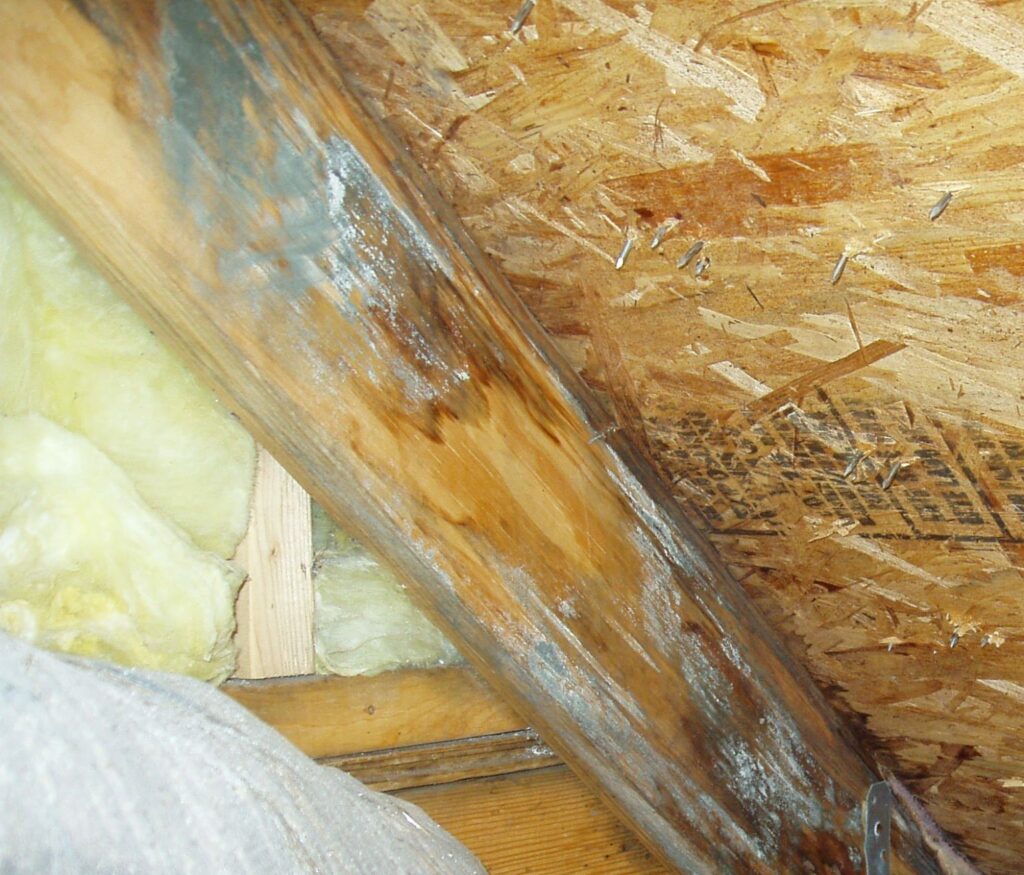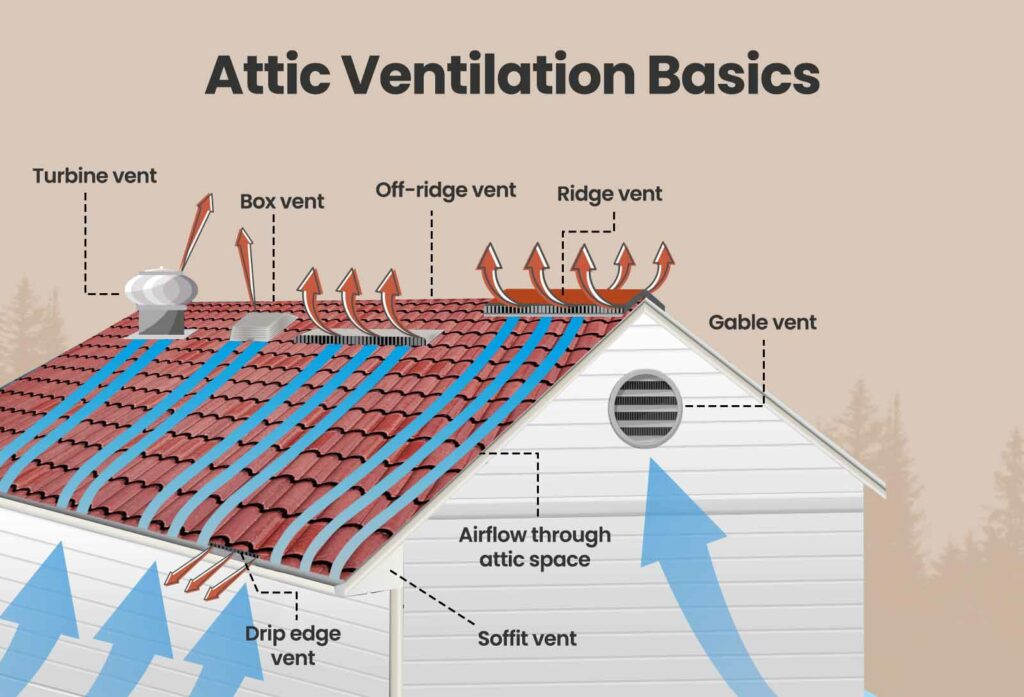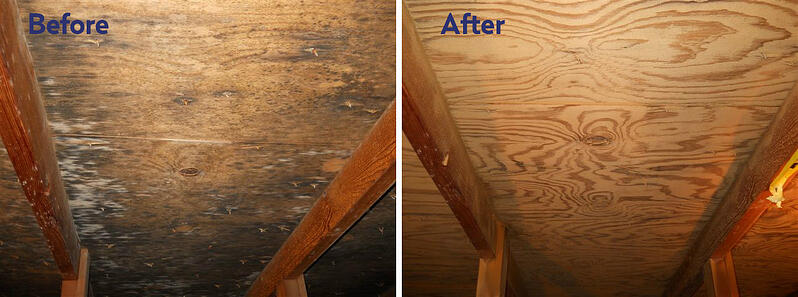
Mold in the attic of your home can pose serious health risks and damage your home if not managed quickly and effectively. If you notice any signs of mold in your attic, it’s essential to address the problem right away. This guide will take you through identifying attic mold, understanding prevention techniques, removing mold, and estimating removal costs. Let’s dive in to help you keep your attic — and your home — safe and mold-free.
Spotting mold in the attic early can save you from dealing with costly damage and extensive health risks. Here are the primary indicators of mold in your attic:
1. Dark Stains
Mold thrives in moist conditions, often appearing as brown or gray stains on porous materials like wood. If you notice these dark marks, it could be an indication of mold taking root in your attic.
2. Musty Odor
A distinct, musty smell in your attic could signal mold growth. This odor comes from volatile organic compounds produced by spreading mold. If your attic smells musty, it’s time to check for mold.
3. Allergic Reactions
Exposure to attic mold can lead to allergic symptoms, including skin rashes, eye irritation, and redness. If you or family members have unexplained allergy-like symptoms, check the attic for mold, even if no one has known allergies.
4. Frost Buildup
Poor attic ventilation can lead to moisture freezing on roof surfaces in cold climates. This frost buildup may later melt and encourage mold growth when temperatures rise.
5. Stuffy Atmosphere
If your attic feels stuffy or too warm, it may indicate poor insulation or blocked vents. This kind of environment is a breeding ground for mold, even if you don’t see it yet.
6. Visible Mold
If you see visible mold patches, you’re likely dealing with a well-established issue. Visible mold often suggests there’s more hidden mold growth in places like insulation, drywall, or ceilings. Address it promptly to prevent further spread.

Prevention is your best defense against attic mold. Use these strategies to keep mold in the attic at bay:

1. Ventilation
Proper ventilation helps regulate attic temperature and moisture, minimizing the chances of mold. Make sure your attic has a balanced ventilation system with both intake and exhaust vents.
2. Insulation
Good insulation reduces condensation in your attic by helping maintain temperature consistency. This prevents moisture buildup, which is crucial in avoiding mold growth.
3. Clear Gutters and Downspouts
Clogged gutters and downspouts can lead to water backup, which can seep into your attic and encourage mold growth. Regularly clear out gutters to prevent moisture problems.
4. Use Exhaust Fans
Ensure bathroom and kitchen fans vent directly outside, not into the attic. Moisture from these areas can easily fill your attic, creating a humid environment that’s perfect for mold.
5. Fix Roof Leaks
Leaky roofs are a common cause of mold in attics. Regularly inspect your roof for any potential leaks, and repair them promptly to keep moisture out.
If you’ve discovered mold in your attic, follow these steps to remove it safely and effectively:

1. Address Moisture Issues First
Mold thrives on moisture, so before removal, identify and resolve any moisture problems. A dehumidifier can help reduce humidity in the attic to slow mold growth during the cleanup.
2. Improve Ventilation While Cleaning
Open any available windows and use fans to promote airflow and prevent mold spores from spreading to other areas of the house.
3. Wear Safety Gear
Mold removal can expose you to spores that cause health issues. Wear safety goggles, gloves, a mask, and old clothing that you’re comfortable discarding after the process.
4. Clean and Disinfect Affected Areas
To clean moldy surfaces, you can use a bleach solution or white distilled vinegar. Spray the solution on the moldy areas, let it sit for 10-15 minutes, then scrub the surface to remove mold stains and disinfect the area.
5. Consider Professional Help
Attic mold removal can be challenging and potentially hazardous. If the mold covers a large area or you’re unsure how to proceed, it’s wise to call in mold mitigation professionals who can safely and effectively handle the cleanup.
Professionals use various techniques to ensure thorough mold removal and prevent future growth:
The cost of attic mold removal varies depending on several factors, including the extent of mold, attic size, and accessibility. Here’s a general pricing guide:
Professional Removal Costs: Hiring a professional typically costs around $1,500 to $3,500 for moderate attic mold issues. Large infestations in complex attics can push costs to $7,000 or higher.
General Cost: Attic mold removal can range from $1,000 to $10,000. Factors that affect cost include attic square footage, mold severity, insulation type, roof leak repairs, and disposal needs.
Whether insurance will cover attic mold removal depends on the cause. Homeowner’s insurance generally covers mold caused by a “covered peril” — a sudden or accidental event such as:
However, if mold has developed gradually due to neglected leaks or poor maintenance, it’s often considered preventable damage and is not covered by insurance. If your attic is prone to moisture issues, check your policy and consider any endorsements or additional coverage options specifically for mold.
Regular inspections are key to keeping mold from becoming a problem. Periodically check for leaks, maintain good ventilation, and remove any moisture-prone materials or debris from your attic. Addressing any minor issues before they become significant can save you both time and money.
By following these prevention strategies and understanding how to handle mold if it does occur, you’ll be well-prepared to keep your attic — and your entire home — healthy and mold-free.